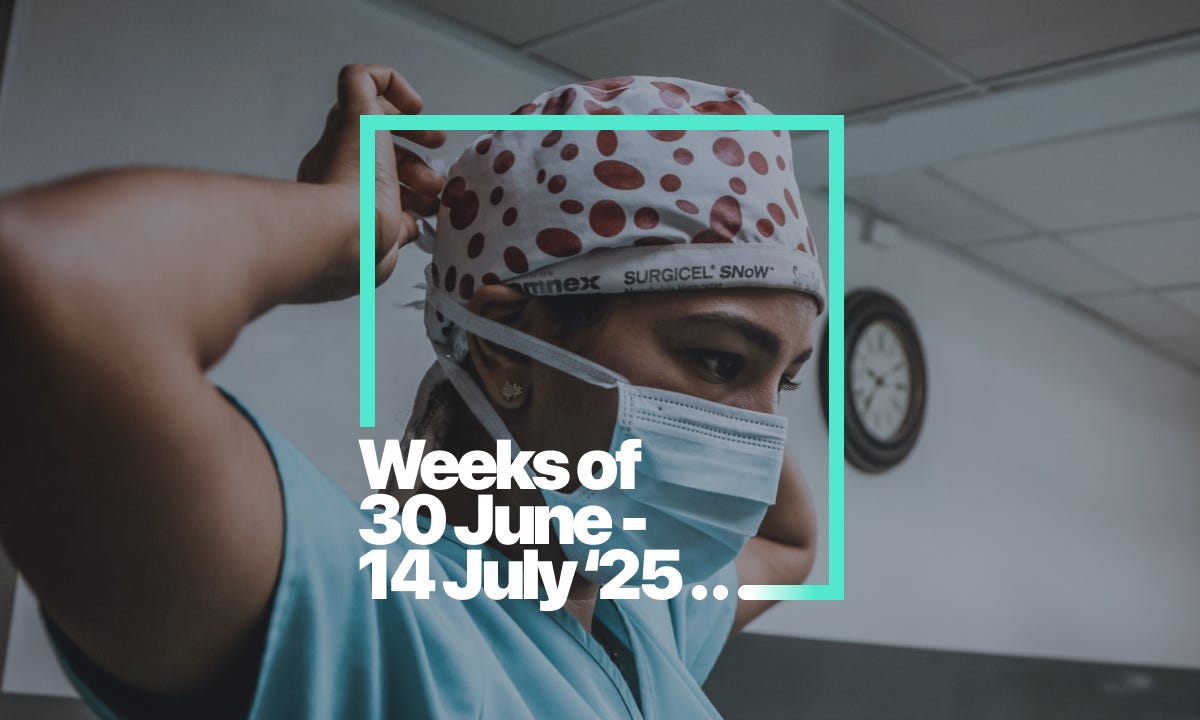Hello 👋 get a brew on because these are the top emerging risks between June 30th, and July 14th, 2025…
Review our report’s terminology here ↗
Our main risk this fortnight is…
1. Societal: America's Medical school debt crisis (A healthcare catastrophe set for 2037)
$200,000 lifetime cap on Federal Direct Unsubsidised Stafford Loans for professional school - far below the $286,454 median cost for public medical schools and $390,848 for private institutions
Graduate PLUS loans eliminated entirely starting July 2026 for new borrowers (2029-2030 for existing borrowers) - this program previously allowed students to borrow up to full cost of attendance
71% of medical students already graduate with over $212,000 in debt, with the average being $212,341 according to AAMC data
187,130 physician shortage projected by 2037 - including 87,000 primary care doctors - while rural areas face a 56% shortage compared to 6% in urban areas
Medical school costs are the #1 reason qualified applicants don't apply, according to the American Medical Association, making this legislation particularly damaging during an existing physician crisis
Sources
Medical students fret over the new student loan cap in the 'big, beautiful bill' | July 9, 2025 | NBC News
Med Students Say Big, Beautiful Bill's Student Loan Cap Means They Won't Be Able to Finish School As Experts Predict Massive Doctor Shortage by 2037 | July 7, 2025 | Latin Times
3 ways Trump's 'big beautiful' bill will change how students and families pay for college | July 10, 2025 | CNBC
Federal student-loan changes would worsen physician shortage | June 3, 2025 | American Medical Association
You should be concerned if…
Healthcare facilities and health systems: You're facing an accelerating staffing crisis that will worsen recruitment challenges significantly, with rural hospitals already closing services and primary care deserts expanding
Businesses in rural communities: When hospitals close or reduce services due to physician shortages, entire communities become less attractive for business investment and workforce recruitment, creating cascading economic impacts
Companies dependent on healthcare access for workforce: Especially in rural or underserved areas, you're looking at reduced service availability, longer wait times, travel requirements for specialised care, and limited emergency services that will directly impact business operations
Medical education sector and healthcare financing industry: The financial model just broke for medical schools facing declining applications from qualified candidates, while insurers face increased pressure to fill gaps in medical education funding amid rising healthcare costs from physician shortages
These items are generic assumptions. We recommend considering your own unique risk landscape against your critical dependencies. If you don’t know what they are, get in touch.
Preventative actions
Diversify Healthcare Provider Relationships
Don't rely solely on traditional physician networks - develop partnerships with nurse practitioners, physician assistants, and tele-health platforms to maintain service continuity as physician availability decreases.
Invest in Employee Health and Wellness Programs
With reduced healthcare access coming, preventing health crises becomes more critical than treating them - comprehensive wellness programs, mental health support, and preventive care reduce workforce dependence on increasingly scarce medical services.
Explore Telemedicine and Digital Health Solutions
Implement platforms like Teladoc and MDLive for remote consultation capabilities that bridge gaps in local healthcare availability when traditional medical access deteriorates.
Consider Healthcare Benefits Restructuring
Offer direct primary care arrangements, health savings accounts, and medical travel benefits - creative benefit structures help retain talent and ensure care continuity as healthcare access becomes more challenging.
Develop Medical Emergency Contingency Plans
For businesses in rural areas or remote operations, establish clear protocols for medical emergencies including first aid training, emergency transport arrangements, and partnerships with distant facilities when local healthcare infrastructure is limited.
Support Local Healthcare Infrastructure
Consider partnerships with local hospitals, funding for residency programs, or support for rural health clinics - businesses that invest in healthcare infrastructure protection maintain competitive advantages in affected regions.
2. Technological: Why ANZ leaders think cyber recovery takes days, not weeks
80% of ANZ business leaders believe they can recover from cyberattacks within 5 days, with nearly a quarter expecting full recovery in just 24 hours, according to Commvault's "State of Data Readiness" report surveying 408 IT and business leaders.
Reality shows 4-week average recovery time for minimum viable operations, with over 55% of organizations taking more than a week to return to even partial operation and 20% needing 45 days for full recovery - nearly double the global average.
70% of ANZ organizations experienced cyberattacks in the past 12 months with almost all facing ransomware demands, yet despite 54% having "no payment" policies, 15% still paid when reality hit.
50% of ANZ organizations have "very immature" cyber resilience capabilities with only 4% believing they have proactive, mature capabilities, while only 12% rated their ability to operate effectively during attacks as "excellent"
Sources
Cyber confidence crisis: ANZ Business leaders 'vastly overrate cyber resilience' | July 9, 2025 | iTWire
Commvault Study Reveals Majority of ANZ Business Leaders Overestimate Cyber Preparedness, Face Panic in Aftermath of Cyberattacks | July 7, 2025 | News Hub
The State of Data Readiness and Cyber Resiliency in ANZ | May 8, 2025 | Commvault
Commvault Study Reveals Cyberattack Confidence Gap Among Asia's Business Leaders | July 9, 2025 | The Fast Mode
You should be concerned if…
Regulated industries (banking, healthcare, government, utilities): You face both operational disruption and severe compliance penalties when recovery times extend beyond expectations, with regulatory bodies increasingly holding organisations accountable for cyber resilience failures
Digital operations and cloud-dependent businesses: E-commerce platforms, SaaS providers, and technology companies face immediate revenue loss when recovery takes weeks instead of days, with customer churn accelerating during extended service restoration periods
Critical supply chain operators (manufacturing, logistics, retail): Extended downtime cascades through partner networks, and when your recovery takes four weeks instead of four days, suppliers and customers make permanent alternative arrangements
Organisations handling sensitive customer data: Extended recovery periods mean prolonged exposure to regulatory action, class action lawsuits, and permanent reputation damage when personal information, financial records, or health data remains compromised
Preventative actions
Implement Realistic Recovery Testing
Test incident response plans quarterly, not annually, including business stakeholders alongside IT teams - research shows organisations with mature testing practices recover 41% faster than those without
Develop Minimum Viable Recovery Capabilities
Focus on restoring critical business functions within 72 hours rather than perfect operations - identify your five most critical systems and ensure independent restoration from primary infrastructure
Establish Isolated Recovery Environments
Maintain air-gapped, immutable copies of critical data and applications - organisations with proper isolation recover significantly faster by rebuilding from clean, verified backups rather than cleaning infected systems
Invest in Automated Recovery Orchestration
Deploy automated runbooks and recovery-as-code approaches to reduce human error and accelerate restoration times - manual recovery processes that work in testing often fail under pressure
Build Cross-Functional Incident Response Teams
Create teams including operations, finance, legal, and communications alongside technical staff - the confidence gap exists partly because business leaders don't understand technical realities
Establish External Recovery Partnerships
Arrange pre-established relationships with external providers for temporary infrastructure, expertise, and communication channels when primary systems are compromised
Implement Continuous Resilience Monitoring
Deploy tools that continuously validate recovery capabilities rather than relying on periodic testing - organisations with real-time resilience monitoring identify and address gaps before incidents occur
Quick snippet stories
Italy's New Mandatory NatCat Insurance for Businesses
Italy has introduced mandatory natural catastrophe insurance for all enterprises to reduce economic impact from extreme weather events. The framework promotes greater financial resilience through risk mitigation and public reinsurance mechanisms.
Between ambition and ambiguity: Italy's new mandatory NatCat insuranceResearcher tricks ChatGPT into revealing security keys - by saying "I give up"
A security researcher exposed ChatGPT vulnerabilities by tricking the AI into revealing Windows product keys using simple phrases. The attack demonstrates how AI safety measures can be circumvented through social engineering.
Researcher tricks ChatGPT into revealing security keys - by saying "I give up"AI Overviews hallucinates that Airbus, not Boeing, involved in fatal Air India crash
Google's AI Overviews is spreading misinformation about the Air India Flight 171 crash, incorrectly claiming it involved an Airbus instead of a Boeing 787. This highlights risks of AI-generated search summaries during breaking news events.
Google AI mistakenly says fatal Air India crash involved Airbus instead of BoeingGoogle Cloud outage brings down a lot of the internet
A Google Cloud outage brought down major internet services including Spotify, Discord, and Cloudflare for over three hours. The failure originated from a software bug that spread globally, demonstrating cloud infrastructure fragility.
Google Cloud outage brings down a lot of the internetTikTok flooded with deepfake copies of real creators' videos
TikTok is flooded with AI-generated deepfakes copying successful creators' content word-for-word using synthetic faces and voices. These bots avoid detection by appearing different, with some fake videos attracting over 200,000 views.
TikTok flooded with deepfake copies of real creators' videos
Want to discuss how these risks might effect your business?
Book 30 minutes with us, free ↗
Need support?
At Fixinc, we are passionate about helping people get through disasters. That’s why our team of Advisors bring you this resource free of charge. If you need help understanding these threats and building a plan against them, the same Advisors are here to help over a 30-minute online call. Once complete, if you like what was provided, you can choose to provide a donation or subscribe to Unreasonable Ventures to support this channel.

















